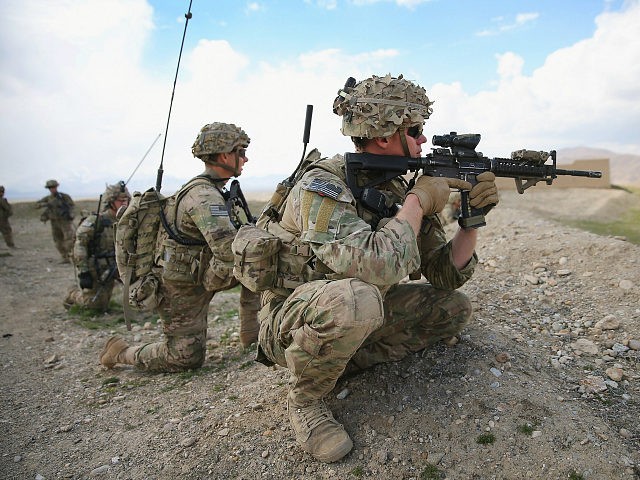U.S. President Donald Trump revealed over the weekend that he is considering leaving behind a residual U.S. military intelligence presence after the prospective withdrawal from the more than 17-year-old war in Afghanistan in exchange for a potential peace pact with the Taliban.
Echoing comments from CIA Director Gina Haspel to U.S. lawmakers last week, President Trump suggested in an interview with CBS News that aired Sunday that intelligence troops would monitor the Taliban’s promise of preventing any group from using Afghanistan for international terrorism, made recently as part of a framework for a peace agreement reached by the group and the United States.
Retired U.S. Army Col. Chris Kolenda, who helped set up a back channel with the Taliban, told the Daily Beast in August 2018 that the terrorist group has also expressed a willingness to allow a small American military force to remain in Afghanistan post a significant withdrawal.
Asked if the Taliban can be trusted during the CBS News interview that aired Sunday, President Trump responded:
We’ve been there for 19 years, almost, we are fighting very well. We’re fighting harder than ever before. And I think they’re [Taliban] tired and, I think everybody’s tired. We got to get out of these endless wars and bring our folks back home. Now, that doesn’t mean we’re not going to be watching with intelligence. We’re going to be watching, and watching closely.
Responding if he would consider leaving behind a small U.S. military contingent in Afghanistan, the American commander-in-chief said, “Yes. And I’ll leave intelligence there. Real intelligence, by the way. I’ll leave intelligence there and if I see nests forming, I’ll do something about it.”
“We’ll come back if we have to. We have very fast airplanes, we have very good cargo planes,” he added. “We can come back very quickly, and I’m not leaving. We have a base in Iraq and the base is a fantastic edifice.”
President Trump has said there are no plans to withdraw the nearly 5,000 American troops in Iraq, deployed as part of U.S. Central Command (CENTCOM), charged with military operations in the Middle East and Afghanistan.
Reports surfaced late last year saying that the Trump administration was considering withdrawing half of the 14,000 U.S. troops deployed to Afghanistan. The White House, however, said President Trump had not ordered the Pentagon to withdraw.
Soon after the president suggested there may be a military withdrawal from Afghanistan, the Republican-led Senate voted to keep American troops in the country on Monday.
That day, Afghanistan’s Chief Executive Abdullah Abdullah said the United States had not officially mentioned anything about reducing its military presence in Afghanistan, Khaama Press (KP) reported.
Afghan President Ashraf Ghani told CBS News early last year that the Afghan security forces would not last more than six months and the Kabul government would collapse if the United States were to withdraw its financial and military support. Abdullah said that, despite this, the partial withdrawal of U.S.-led foreign forces would not spell the end of the world for Afghanistan.
After a bitterly disputed vote, the U.S. brokered a power-sharing agreement between Ghani and Abdullah in 2014.
CIA Director Haspel told lawmakers last week that a “monitoring regime” would be necessary to ensure the Taliban keeps its promise of preventing terrorist groups from operating on Afghan soil.
Pentagon officials have long described the U.S. military’s mission in Afghanistan as preventing the country from becoming a haven for groups seeking to attack the American homeland.
The Trump administration has intensified peace-seeking efforts in recent months, making the negotiated “political reconciliation” between the Afghan government and the Taliban the primary goal of its strategy to end the war — raging since October 2001.
Trump’s Special Representative for Afghanistan Reconciliation Zalmay Khalilzad and the Taliban confirmed details of a framework for a peace pact in recent days.
The framework mainly involves the withdrawal of foreign troops in exchange for guarantees from the Taliban that other terrorist groups such as al-Qaeda and the Islamic State (ISIS/ISIL) will not use Afghanistan to plan or execute attacks against the United States.
Trump administration officials are also asking the Taliban to observe a ceasefire and open dialogue with the Afghan government in exchange for a pull out of foreign military forces.
Taliban jihadis have long refused to negotiate with the Afghan government, dismissing it as an American “puppet.”
The United States has devoted a significant amount of blood and treasure to its most protracted foreign military engagement in Afghanistan — nearly $1 trillion, 2,278 military deaths, and 20,425 injuries. Terrorist groups, primarily the Taliban, still control or contest about half of Afghanistan.
Taliban jihadis generate most of their funding from trafficking and cultivating opium and its heroin derivative, some of which is fueling the lethal overdose epidemic in the United States.
Last week, President Trump wrote on Twitter that negotiations with the Taliban “are proceeding well in Afghanistan after [nearly] 18 years of fighting.”
The Taliban narco-jihadi group, which is fighting to implement strict Islamic laws or sharia, considers itself the only legitimate government in Afghanistan.
According to the Pentagon, the Afghanistan-Pakistan region is home to the highest concentration of terrorist groups in the world.

COMMENTS
Please let us know if you're having issues with commenting.